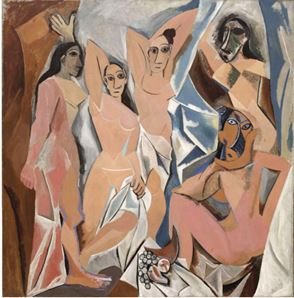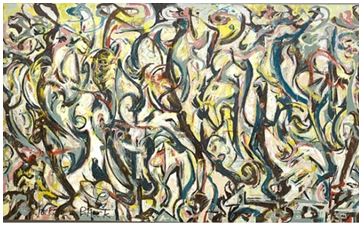Cubism and abstract expressionism emerged from art revolution that attracted new artists who remained innovative in the artwork. The two art movements took advantage of technological advancement in the 19th century and tried to bring “whole” artwork again with aesthetic value, vitality, and clarity. Through cubism and abstract expressionism art, most artists ended up “realization that art quality is a property of the artwork itself, existing apart from any external measure” (Walter Darby Bannard Archive 1968). The artists also learned from the two forms of art movements that expressive artwork depends on “visible and tangible things in terms of space” (Walter Darby Bannard Archive 1968). The attitude of artwork changed, and materials used by cubism artists affected the way they made paintings. The free use of painting materials used by artists had the power to change art quality and bring abstraction to the service. Cubism manifested abstract painting that depended on expressive materials such as sensual paint and effective color but in small scale.
Cubism artists used spatial elements that would produce soft and sensuous painting with sharp edges. Not only was seen as abstract painting, but cubism also appeared like a space-painting that emphasized on an element of depth in space. The elements and styles used in cubism led to the art of abstract expressionism that appeared on a large scale. Unlike early cubism that required “cutting stroke made by a small brush, loaded with paint, worked by the wrist and fingers,” (Walter Darby Bannard Archive 1968) abstract expressionism excluded the wrist-finger technique because it was inadequate for its large scale that was required to be filled with paint. Abstract expressionism became large-scale cubism, and artists in this form wanted to blow up the small-scale technique in early cubism. The new artists adapted large scale painting using brush, paint, color, and distinguish planes.
Abstract expressionism and cubism art had a lot of similarities in terms of techniques of painting, application of paint, color, and scale. Apart from style, the two forms of art carried similar cultural contests that would attract many audiences. That is why most abstract expressionists would still apply the vibrancy of small-scale Cubism but used large brushes and lots of paintings. Abstract expressionists disturbed the scale and depth illusion of Cubism but remained with the spirit of increasing visibility of the service on the edges. One of the good cubists was Pablo Picasso, who got interested in abstract painting. As a Cubism artist, Picasso did not divert from the elemental visual fact of space in depth. He applied small painting technique, and most of his paintings were designed to express. The use of small scale painting was to put the whole scene in one small unit because Cubism evolves abstracting natural objects (Walter Darby Bannard Archive 1968).
One of the great masterpieces of Picasso was “Les Demoiselles d’Avignon” (1906), which the cubist painted to express his feelings about sexuality. The painting depicts nude women in aggressively sexual postures, and the artist wanted to “offer idealized representations of female beauty” (Margrain 2015). Through this piece, it showed how Cubism “abandoned all known form and representation of traditional art” (Margrain 2015). The innovative piece depicts a transition from traditional artwork to modern art in purely formal terms. The painter used his confidence and personality to create oil painting on canvas, and he did not forget heavy paints was to express his feelings. The images of the piece appeared sharp in geometric shapes with a twisted figure and two-dimensional style. The artwork carried modern cultural narratives and themes such as morality, beauty, and prostitution (Chave 1994). Such themes allowed viewers to understand the nature of society. Picasso also used the piece to express historical aspects of the community in which he lived.

Pablo Picasso, “Les Demoiselles d’Avignon,” 1907. Oil on canvas
In abstract expressionism, Jackson Pollock proved to be a great painter who came with a unique style of drip painting (Duvernois & Silvia 2017). A good example is the “Mural” (1943) paintings on the medium of oil and casein on canvas. The artist applied the technique of large-scale brush stroking. Mural explored the style of visual space drip or spots paintings and amoeba-like anthropomorphic forms of images (Teicholz 2017). It appeared as an original brilliance portrait with a depth of heavy color and creativity. In terms of cultural context, Pollock’s piece depicts a liberation of artists from restrictive traditions techniques of painting to a more active and creative painting that intended to express (Doss 2017). It expressed a creative force of the unconscious and opened the minds of viewers so that they can understand the nature of society. Through the paintings, the artists tried to show a transition to modernism art, where artists adapted a culture that believes that any portraits need to satisfy the attention of the viewers. It should support the aesthetic value of art.

Jackson Pollock “Mural,” 1943; medium: oil and casein on canvas.
The two pieces, Les Demoiselles d’Avignon and Mural, had a lot of similarities because they emerged from art movements that appeared in the same period. Abstract expressionism was manifested from Cubism; that is why the styles and cultural contest between the two were very much alike. The main difference between the two was Cubism was a small-scale style that required small brush, loaded with paint, worked by the wrist and fingers, while Abstract expressionism was on a large scale, and the paint used was in large quantity. All these aspects can be identified from the two pieces. The drip painting style found in Mural was unique in modern art, and just like the cubists, Pollock used the style as a way of expressing and fascinating the viewers. The two pieces also seemed to have a similar cultural context that mainly depicts a transition from traditional artwork to modern art in purely formal terms. Lastly, I think Cubism and Abstract expressionism were evolutionary change in the art that disqualified the traditional art forms of the past and set up a modernism art-making.
Works Cited
Chave, Anna C. “New encounters with Les Demoiselles d’Avignon: Gender, race, and the origins of cubism.” The Art Bulletin 76.4 (1994): 596-611.
Duvernois, Isabelle, Julie Arslanoglu, and Silvia A. Centeno. “Cut from the Same Cloth: A Technical Comparison of Jackson Pollock’s Pasiphaë and Mural.” Getty Research Journal 9.S1 (2017): 61-78.
Doss, Erika. “Arrival and Afterlife: Jackson Pollock’s Mural and the University of Iowa.” Getty Research Journal 9.S1 (2017): 117-132.
Margrain, Daniel. “Why Picasso’s ‘Les Demoiselles D’Avignon’ Still Resonates Today.” Road To Somewhere Else, 20 Nov. 2015,
Teicholz, Tom. “Jackson Pollock’s ‘Mural’: Masterpiece or Macho Outburst?” HuffPost, HuffPost, 7 Dec. 2017, Walter Darby Bannard Archive, wdbannard.org/1968-Cubism-AbEx-And-David-Smith-5.html
Delivering a high-quality product at a reasonable price is not enough anymore.
That’s why we have developed 5 beneficial guarantees that will make your experience with our service enjoyable, easy, and safe.
You have to be 100% sure of the quality of your product to give a money-back guarantee. This describes us perfectly. Make sure that this guarantee is totally transparent.
Read moreEach paper is composed from scratch, according to your instructions. It is then checked by our plagiarism-detection software. There is no gap where plagiarism could squeeze in.
Read moreThanks to our free revisions, there is no way for you to be unsatisfied. We will work on your paper until you are completely happy with the result.
Read moreYour email is safe, as we store it according to international data protection rules. Your bank details are secure, as we use only reliable payment systems.
Read moreBy sending us your money, you buy the service we provide. Check out our terms and conditions if you prefer business talks to be laid out in official language.
Read more